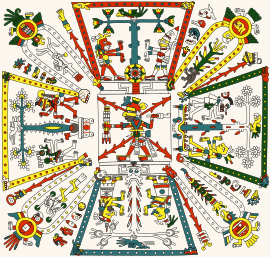Codex Fejérváry-Mayer

The Codex Fejérváry-Mayer is an Aztec Codex of central Mexico. It is one of the rare Native American manuscripts that have survived the Spanish conquest of the Aztec Empire. As a typical calendar codex tonalamatl dealing with the sacred Aztec calendar – the tonalpohualli – it is placed in the Borgia Group. It is a divinatory almanac in 17 sections. Its elaboration is typically pre-Columbian: it is made on deerskin parchment folded accordion-style into 23 pages. It measures 16.2 centimetres by 17.2 centimetres and is 3.85 metres long.[1]
History
The earliest history of the codex is unknown. It is named after Gabriel Fejérváry (1780–1851), a Hungarian collector, and Joseph Mayer (1803–1886), an English antiquarian who bought the codex from Fejérváry. In 2004 Maarten Jansen and Gabina Aurora Pérez Jiménez proposed that it be given the indigenous name Codex Tezcatlipoca, from the Nahuatl name of the god Tezcatlipoca (who is shown, with black-and-yellow facial striping, in the centre of its first page), although it is not certain that its creators were Nahuas.[2]
It is currently kept in the World Museum Liverpool in Liverpool, England, having as its catalogue # 12014 M.[3] It is published in Volume 26 of the series Codices Selecti of the Akademische Druck - u. Verlagsanstalt - Graz. It is believed to have originated specifically in Veracruz.
Gallery


See also
- Aztec codices
- Borgia Group
Notes
- ^ Glass, John B. in collaboration with Donald Robertson. "A Census of Native Middle American Pictorial Manuscripts". article 23, Guide to Ethnohistorical Sources Part 3; Handbook of Middle American Indians. University of Texas Press 1975, census #118 p. 128ISBN 0-292-70154-3
- ^ Jansen and Pérez Jiménez (2004, p.270).
- ^ The Codex Fejérváry-Mayer: History, National Museums Liverpool.
References
- Boone, Elizabeth Hill. Cycles of Time and Meaning in the Mexican Books of Fate. Austin: University of Texas Press.
- Dia, Gisele; Rodgers, Alan (1993). The Codex Borgia. New York: Dover Publications.
- Jansen, Maarten; Jiménez, Gabina Aurora Pérez (2004). "Renaming the Mexican Codices". Ancient Mesoamerica. 15 (2): 267–271. doi:10.1017/S0956536104040179. hdl:1887/16354. ISSN 0956-5361. S2CID 163136552.
External links

- A.D.V.G. facsimile of the Codex Fejérváry-Mayer
- B.B.A.W. facsimile of the Codex Fejérváry-Mayer
- page-by-page commentary, by Eduard Seler, on the Codex Fejérváry-Mayer (in German)
- similarities in content between Codices Fejérváry-Mayer and Borgia
- v
- t
- e
- Codex Borgia
- Codex Cospi
- Codex Fejérváry-Mayer
- Codex Laud
- Codex Vaticanus B
- Fonds Mexicain 20
- Codex Porfirio Díaz
 | This article about a manuscript is a stub. You can help Wikipedia by expanding it. |
- v
- t
- e
 | This article related to indigenous Mesoamerican culture is a stub. You can help Wikipedia by expanding it. |
- v
- t
- e












